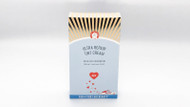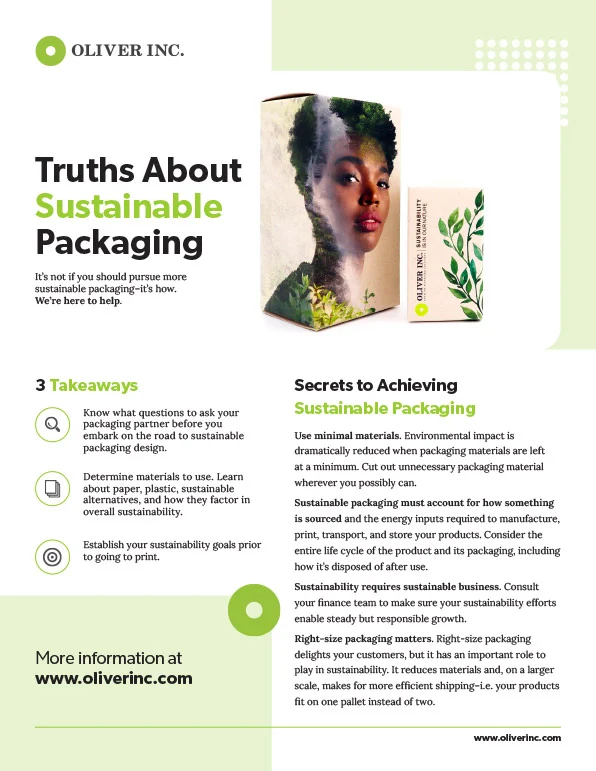What Is Foil Stamping?
Posted by Oliver Inc. on 26th May 2022
Picture yourself walking the aisles of a retail store.
When you get to the health and beauty section, the brands jump off the shelves, their metallic logos shining brilliantly against dark backdrops. They exude elegance. They convey perfection.
Think back to the box of chocolates you bought a loved one on Valentine’s Day, where the graphics elevated its contents from sweet treats to heavenly bites of luxurious goodness. Remember the wedding save-the-date that lived on your refrigerator: bold stylings capturing the celebratory importance of the ceremony ahead.
All are examples of foil stamping, also called hot stamping, whereby metallic or colored foil is applied to various materials for a flashy, lustrous effect. Individuals and brands have been using this for decades to boost their products' appeal with eye-catching features. In its earlier days, foil stamping was an expensive, complex technique reserved for luxury brands.
As technologies have improved—in die-cutting machines and available materials—foil stamping has grown in popularity across a wide range of industries, for various purposes: marketing collateral and secondary packaging, such as folding cartons, among these.
Although it remains a relatively expensive decorative choice, brands might find it’s the right one for them.
Here’s what you need to know about foil stamping.
The History of Foil Stamping
Conjuring a glamorous shimmer that appears unmistakably modern, foil stamping actually goes back centuries.
Gold and silver (really anything metallic in appearance) have always conveyed wealth, importance, and quality, so people found ways to incorporate this wherever they could afford to do so.
Because rudimentary stamping was labor-intensive—involving individual set letters or custom dies—it was reserved for special texts. That changed toward the end of the 19th century as technology improved, and hot foil stamping became a popular choice for publishing companies who wanted readers to judge books by their covers.
Later on, hot stamping spread to folding cartons, printed materials, and packaging. It dominated luxury brands, still attached to gold and all its connotations. During the last 20 years or so, though, the technique has expanded across industries.
Advanced die-cutting technologies enable virtually any brand, with the budget to afford it, to take advantage of the method. Just look throughout your house: the books on the shelves, the makeup packaging in the bathroom, jewelry boxes, and chocolate boxes—chances are, you’ll find some examples of foil stamping.
The Foil Stamping Process
The days of individually stamping literal gold leaves are long gone. Sophisticated, precise die-cutting machines are now the norm, making massive foil stamping jobs both easy and affordable.
The core of the technique remains the same:
- A custom die is created to match the desired shape, and attached to the machine.
- A foil (we tend to think of it as metallic, but it now comes in a variety of colors, finishes, and textures) is dispensed over the substrate, with heat and pressure applied, against a counter plate.
- As the substrate passes through the machine, the die-cut stamps down in the blink of an eye, cutting the foil.
- The excess foil is peeled away, leaving a clean finish.
- The finished sheet is delivered for the next process.
What Foil Stamping Can Do for Your Product
Through all of its changes, foil stamping has retained its classic appeal. It immediately adds luxury to your brand while drawing consumers’ eyes.
But the modern answer to “What can foil stamping do for my product?” is succinct and open: whatever you’d like it to do.
Technologies have made foil stamping more than an eye-catcher these days. It can be used to elevate your brand—literally—when combined with embossing. It can add flashy depth when coupled with debossing. Metallics, although still popular, especially with cosmetic brands, are hardly the only option. Hot stamping can be used to add glossy or contrasting textures to make the image pop. Advancements in digital filing and die-cuts facilitate more intricate designs as well.
Cold foil stamping is another similar option, as well, relying on ultraviolet light rather than heat to apply foil. Dispensed from a roll mounted inline and placed over a substrate, the gleaming design is attached using a UV adhesive.
In addition to traditional industries, newer ones such as cannabis are making use of foil stamping in packaging to suggest a premium quality to their products.
Both foil stamping options enable you to tap into your creative side. You know your product better than anyone. Now, you can work with a printer to find the technique that speaks to your customers. Convey how the product feels, the emotions it should inspire, and the trust it can build with a stamp of quality.
Then again, it’s not always the right choice. Depending on your budget, industry, and product, other ornamental elements might be more appropriate. After all, although it’s more common, foil stamping is still an expensive process because of the customized dies. The heavy metal needs to be molded just right.
That’s why choosing the right printing and packaging partner is so crucial. Their resources and capabilities are important, but so, too, is their expertise. They should help guide your decision-making process.
For example, your budget should be the first point of discussion. Because if it’s limited, then you probably should seek an alternative decorative effect—premium metallic inks, for instance. They won’t match foil shine for shine, but they can mimic the desired imaging when printed on the right surface. The other talking point is the size of the area you wish to have stamped: Small scripts and logos work great; larger ones tend to be too expensive to make foil stamping a cost-effective choice.
If nothing else, understanding foil stamping unlocks your creativity. It gets you thinking about the design of your packaging, where the carton is your canvas. And the right combination of effects can help you sell more products while lifting your brand’s image.






